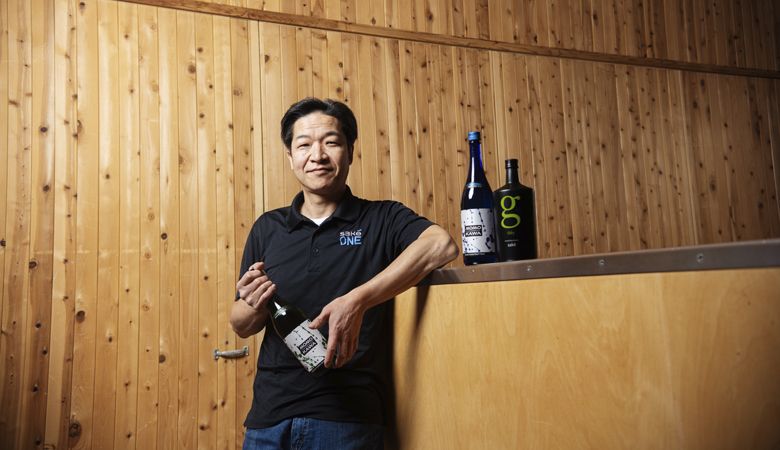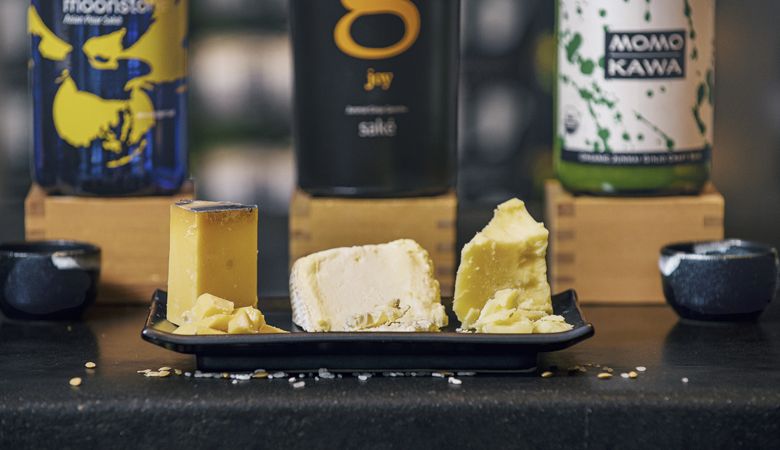Saké & Cheese
Japanese rice spirit meets its mmmatch
For many American consumers, saké suggests a certain mystique. Although it’s often referred to as “rice wine,” it’s really not wine. Nor it is cider or beer. So, what exactly is it?
Saké is an ancient alcoholic beverage made by fermenting rice. Unlike grapes made into wine by the fermentation of fruit sugar, the rice’s starch is converted into sugar and then fermented into alcohol. While the process relates more to brewing beer, saké sommelier Miyuki Yoshida emphatically states, “Saké is a category on its own. Saké is saké!”
According to SakéOne’s associate brand manager, Jessie Sheeran, “Saké is killing it in U.S. markets. It’s kosher, sulfite-free, vegan-friendly, gluten-free and histamine-free, so it checks a lot of healthy boxes.” Ranging from the clear and bright Gingo to the sweeter, cloudy Nigiri, saké’s variety comes from the polishing of the rice. More polish — removing impurities, proteins, etc. — results in fragrant, fruity, elegant aromas.
“There is a challenge of getting people to understand what saké is and what it isn’t,” says SakéOne president Steve Vuylsteke. It’s not all from Japan; it’s not only consumed with Japanese food, and it’s not only drunk cold.” He suggests trying it with salumi or chorizo, or even grilled cheese.
Historically, in the U.S., saké was introduced through Japanese restaurants, so many consumers have long assumed to drink saké only with sushi. But the latest trends reveal saké being savored with all types of cuisines, including Chinese, Italian, French, Mexican and fusion, too — if you’ve not tried it with karaage, Japanese fried chicken, you’re truly missing out. With saké’s variations, chefs and bartenders explore the different densities, textures and flavor profiles with their foods and concoctions — the perfect beverage for someone with a strong culinary imagination.

Yoshida explains, “Saké pairing dinners at non-Japanese restaurants can now be found across the U.S., Europe and Asia. It may surprise you to know that during these multi-course dinners, one of the easiest pairing is actually cheese.” One reason saké lends itself to pairings is its lower acidity — a third less than wine.
Although contemporary Japanese eat cheese as snacks or on pizza, saké with cheese is not an obvious pairing because the latter isn’t incorporated into traditional Japanese cuisine. Yet, on paper, saké and cheese actually make an excellent match.
“They are a natural pairing because they both contain the same lactic acid,” Yoshida explains. “In cheese, lactic acid contributes to the aromas and flavors as it protects against the growth of unwanted bacteria and mold. Saké is made from water, rice, yeast and a mold called koji. Saké’s lactic acid creates a creamy, buttery taste and a yogurt-like nose. Thus, both aged cheeses and saké are high in umami” — the Japanese word for savory exists alongside the other four basic tastes: sweetness, sourness, bitterness and saltiness.
“A good pairing can reveal qualities from the cheese that one wouldn’t discover with wine, beer or cider,” adds Erik Hanson, saké buyer for Giraffe Goods in Portland — owners include his wife, Kana Hinohara Hanson, and Gabe Rosen. “Unlike the ways that wine and the others work in pairings, saké tends to play a more supporting role in the expression of the food that it’s paired with. Broadly, saké works with cheese by confirmation of the traditional pairing approach of serving ‘like with like.’”
Hanson continues, “The expressions of umami in saké are particularly intriguing when paired with cheese, whether they may be nutty, yeasty, oceanic or mushroomy — those are all flavors found in cheeses as well. Although saké can be much more subtle than other alcoholic beverages, it’s that subtlety that can work in lovely ways with cheese. In a particularly apt pairing, there are heightened textural and flavorful components between the two.” He suggests serving saké at room temperature because a cheese’s flavors show best around 60 to 70 degrees.
Paul Willenberg, former beverage director for Nodoguro and saké certified by the WSET, concurs, “I love to pair saké and cheese because wine and cheese is actually an awful pairing. Cheese (and other liquid proteins like dairy and eggs) coat your mouth and inhibit your abilities to taste flavors. Saké, being a grain base like beer, actually has a thicker texture and can stand up to cheese.” He explains how the salt in cheese combines with the complex acids (glutamic, lactic and succinic) in saké to produce an umami experience. Although, he says, this can be achieved by simply ingesting salt with saké, “Cheese is a lot more fun.”
Since there is such an assortment of both cheese and saké styles, Yoshida also suggests “mirror-image flavor pairing” as an ideal place to start. She says, “In general, drier sakés will go better with the sharper and drier cheeses, while the fruity and sweet sakés with good acidity will go well with goat and blue cheeses. Creamy saké, like Nigori (a cloudy-style saké containing some lees) would pair well with creamy cheese.”
Meanwhile, the nutty, salty flavors of dense cheese, like Manchego or Pecorino Romano pair well with a soft, full-bodied saké like Junmai, a pure saké made only from rice, water, yeast and koji (the mold added to steamed rice that converts the rice to sugar and imparts a great deal of the flavor), which often tends to emanate earthy aromas with underlying savory notes.
Some traditional styles of saké, including Kimoto and Yamahai, are made with funky yeast and produce saké with gamier, wilder flavors, which are perfect for funkier cheese. For instance, a rich cheese with depth — think Rogue Creamery’s Rogue River Blue cheese — pairs perfectly with a richer, heavier-style Junmai. Delicate, fresh and mild cheeses, on the other hand, pair well with a premium Daiginjo — the saké’s rice polish ratio is less than 50%, with a very small amount of distilled alcohol added to enhance flavor and aroma.
“If I had to pick one saké as a good, versatile candidate for pairings, I’d go with Watari Bune “55” Junmai Ginjo,” Hanson says. “It has structure and fruit that shine particularly well with aged Gouda as well as big, funky cheeses. For lighter cheeses, Joto Junmai is a versatile pick. It’s nutty and has a little fruit and salinity, and a nice bitter, structured component that works well with lighter cheeses like Tomme de Chevre (a goat’s milk cheese from France) and Appenberger Mutschli (a Swiss cow milk cheese).”
Yoshida suggests a cheese somewhat closer to home: “I may be biased, but one of my favorite go-to cheeses is Seattle’s Beecher’s Handmade Flagship cheese. It’s a semi-hard cow’s milk cheese with a robust, nutty flavor. I enjoy this Beecher’s cheese with all types of saké. I am no cheese expert, so I usually go with my feelings and taste buds. Of course, not all saké will go with any cheese,” she reminds. “There is much here to explore and learn.”














